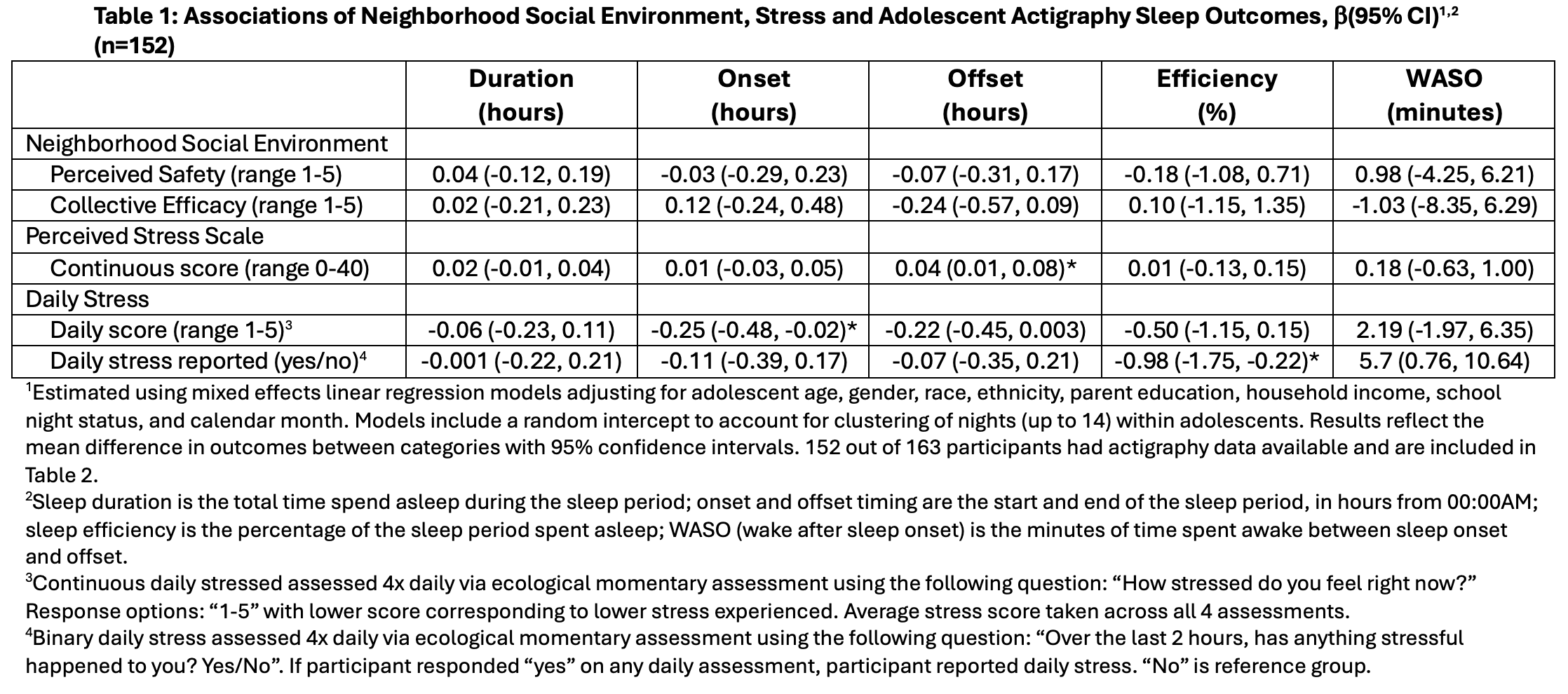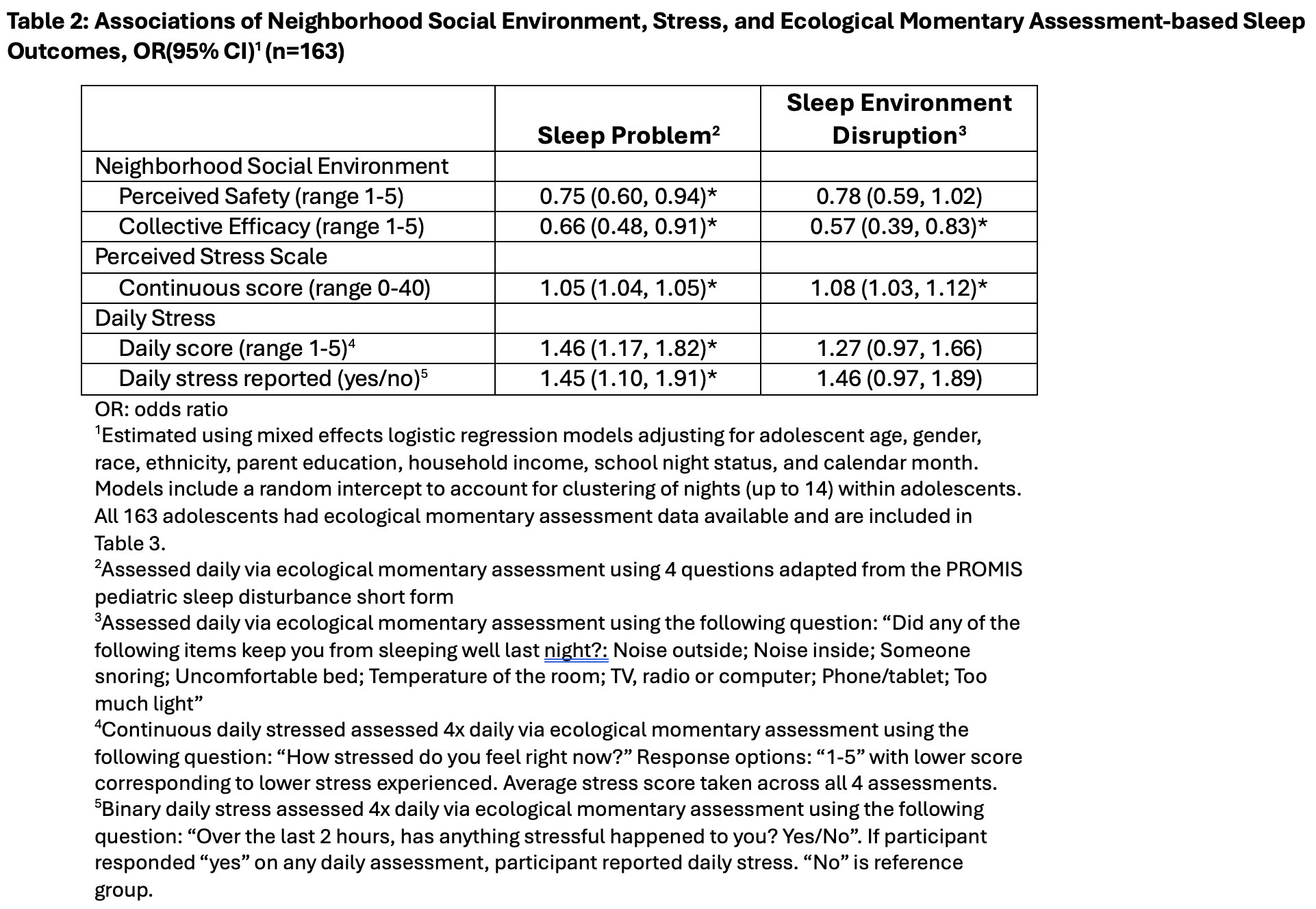Adolescent Medicine 5: Potpourri
Session: Adolescent Medicine 5: Potpourri
134 - Associations between Perceived Neighborhood Environment, Stress and Adolescent Sleep Health
Monday, April 28, 2025
7:00am - 9:15am HST
Publication Number: 134.3684
Gabrielle DiFiore, Children's Hospital of Philadephia, Philadelphia, PA, United States; Hannah martin, Childrens Hospital of Philadelphia, Philadelphia, PA, United States; Jonathan Mitchell, Children's Hospital of Philadelphia, Philadelphia, PA, United States; Douglas Wiebe, University of Michigan Medical School, Ann Arbior, MI, United States; Mathias Basner, University of Pennsylvania, Philadelphia, PA, United States; Alexander G. Fiks, Children's Hospital of Philadelphia, Merion Station, PA, United States; Karen Glanz, University of Pennsylvania, BALA CYNWYD, PA, United States; Stephanie Mayne, Children's Hospital of Philadelphia, Philadelphia, PA, United States
- GD
Gabrielle DiFiore, MPH (she/her/hers)
Clinical Research Project Manager
Children's Hospital of Philadephia
Philadelphia, Pennsylvania, United States
Presenting Author(s)
Background: Adolescents experiencing chronic stress and living in unfavorable neighborhood environments are at greater risk for adverse physical and mental health outcomes. Although existing literature highlights the effects of perceived stress and neighborhood factors on adolescent health, there is limited understanding of their influence on sleep outcomes.
Objective: Examine associations between neighborhood social factors, stress, and sleep outcomes among adolescents.
Design/Methods: We enrolled 163 adolescents aged 15-18 years from Philadelphia between February 2022 and August 2024. Adolescents completed a baseline survey that assessed perceived neighborhood safety and collective efficacy and stress (via the 10-item Perceived Stress Scale [PSS]). Over 14 days, actigraphy measured nightly sleep duration, timing, efficiency, and wake after sleep onset. Adolescents reported daily stress, sleep problems, and sleep environment disruptions (e.g., noise, light) on daily ecological momentary assessments. We used mixed effects linear and logistic regression, with random intercepts to account for clustering of days within adolescents, to analyze associations of perceived neighborhood factors and stress with sleep outcomes, adjusting for age, gender, race, ethnicity, parental education, household income, calendar month, and school night status.
Results: Adolescents averaged 16.2 years old, with 55% identifying as female and 57% as Black. Those who perceived their neighborhoods as safer and with higher collective efficacy had lower odds of sleep problems (Table 1). Higher neighborhood collective efficacy was also associated with lower odds of reporting sleep environment disruptions (Table 2). Neighborhood safety and collective efficacy were not associated with actigraphy-based sleep outcomes. Adolescents with higher PSS scores were more likely to report sleep problems and sleep environment disruptions, but PSS scores were not associated with actigraphy-based sleep outcomes. However, daily stress was associated with lower sleep efficiency (-0.98%, 95% CI: -1.75, -0.22, Table 1) and higher odds of self-reported sleep problems (OR: 1.45, 95% CI: 1.10, 1.91, Table 2).
Conclusion(s): Adolescents perceiving their neighborhoods more positively had lower odds of sleep problems and daily stress, while higher perceived stress was associated with increased sleep disruptions and lower sleep efficiency. However, the lack of correlation of neighborhood safety and collective efficacy with actigraphy-based outcomes suggests that self-reported measures may reflect adolescents’ impressions but not their objectively assessed sleep health.
Table 1: Associations of Neighborhood Social Environment, Stress and Adolescent Actigraphy Sleep Outcomes, Beta(95% CI)

Table 2: Associations of Neighborhood Social Environment, Stress, and Ecological Momentary Assessment-based Sleep Outcomes, OR(95% CI)


